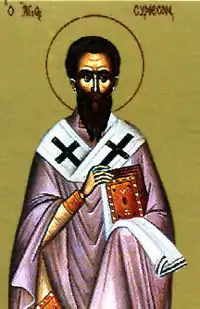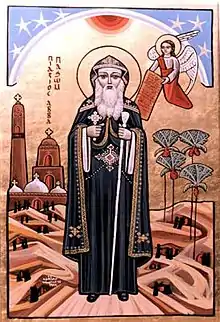| Millennium |
|---|
| 1st millennium |
| Centuries |
| Decades |
| Years |
| Categories |
|
The 340s decade ran from January 1, 340, to December 31, 349.
Events
340
By place
Roman Empire
- Constantinople, capital of Emperor Constantius II, becomes the largest city in the world, taking the lead from Rome, capital of his brother Constans I.[1]
- Constantine II, emperor of the western part of the Roman Empire (Britain, Gaul, the Rhine provinces and Iberia), crosses the Alps and attacks the army of his brother Constans I, emperor of the central part of the Roman Empire (Upper Danube, Italy and middle Africa). They clash at Aquileia in northern Italy. Constantine is killed in a skirmish by an ambush of Constans' troops.
- Constans is left sole ruler of the Western part of the Roman Empire, with his other brother, Constantius II, emperor of the Eastern portion.
By topic
Religion
- Pope Julius I inveighs against Arianism at the Council of Rome.
- Acacius succeeds Eusebius as bishop in the see of Caesarea.
- Wulfila evangelizes among the Goths for 7 years.
341
By place
Roman Empire
- Emperor Constans I bans pagan sacrifices and magic rituals, under penalty of death.
- Constans I begins a successful campaign against the Franks.
India
- Samudragupta of the Gupta Empire, during a decade, extends his kingdom and his influence. A pillar found at Allahabad sings his praises.
By topic
Religion
- The Council of Encaenia is held in Antioch.
- Paul I is restored as Patriarch of Constantinople.
- Thousands of Christians are executed at Seleucia in Mesopotamia.
- Coptic Christianity is introduced into Ethiopia by the Syrian apostle Frumentius. He and his colleague Edesius were captured by Ethiopians a year or two ago, and have become civil servants at the Aksumite court of King Ezana. Frumentius becomes the first Bishop of Axum and encourages the Christian merchants present in the country to practise their faith openly.
342
By place
Roman Empire
- Emperor Constans I campaigns in Britain against the Picts.
- Constans campaigns victoriously against the Franks.
- The Senate abolishes gay marriage.
= Europe =
- A large earthquake strikes Cyprus.
Asia
- Goguryeo is invaded by Murong Huang of the Xianbei.
- Jin Kangdi succeeds his brother Jin Chengdi as emperor of China.
By topic
Religion
- Paul I, Patriarch of Constantinople, is deposed and replaced by Macedonius I.
- February 15 – The original Hagia Sophia is dedicated in Constantinople.
343
By place
Roman Empire
- The Western Roman Emperor Constans I is in Britain, possibly in a military campaign against the Picts and Scots. The last visit to Britain by a legitimate emperor.[2]
- The Eastern Roman Emperor Constantius II campaigns in Adiabene, a vassal kingdom of Armenia (Persian Empire).
By topic
Religion
- Pope Julius I tries to unite the Western bishops against Arianism by convoking the Council of Serdika (later Sofia), which acknowledges the pope's supreme authority and grants him the right to judge cases involving the legal possession of episcopal sees, but only Western and Egyptian bishops attend, and Arianism remains strong.
344
By place
Roman Empire
- The Eastern Roman Emperor Constantius II campaigns in eastern Mesopotamia, against the Sassanid Persians.
- Battle of Singara: The Roman army under Constantius wins a close victory, at the strongly fortified city of Singara (Mesopotamia). His enemy, King Shapur II, is forced to lift the siege, and withdraw the Persian army.
- Shapur II, for the second time, besieges the Roman fortress of Nisibis in eastern Mesopotamia, but is repulsed by forces under General Lucilianus.
Asia
- Jin Mudi, age 1, succeeds his father Jin Kangdi as emperor of China. His mother, Empress Dowager Chu, becomes the ruling authority at court, and serves as regent.
- Gye becomes king of the Korean kingdom of Baekje.[3]
By topic
Art
- The making of a detail of Admonitions of the Imperial Instructress to Court Ladies (attributed to Gu Kaizhi and being from the Six Dynasties period) begins (approximate year) and is completed in 406. It is now kept at the British Museum, London.
Religion
- Bishop Eustorgius I brings relics of the Three Magi from Constantinople to Milan, according to a 12th century legend.
345
By place
India
- Merchant Knai Thomman and 400 followers visit the Malabar Coast in Kerala (India), and assist the church there.
- The Kadamba Dynasty is founded by Mayurasharma.
Italy
- Constans orders the Basilica di Santa Tecla to be constructed in Lombardy.
346
By place
Asia
- In Korea, the Buyeo Kingdom is absorbed by Goguryeo.
- Geunchogo becomes king of the Korean kingdom of Baekje.[4]
By topic
Religion
- Emperor Constans I uses his influence to secure the return of Athanasius. He is restored as Patriarch of Alexandria, and documents are compiled relating to his expulsion, under the title Apology Against the Arians.
- Macedonius I, Patriarch of Constantinople, is deposed again by Paul I.
- Julius Firmicus Maternus writes De erroribus profanarum religionum.
- The Visigoths are converted to Arianism by Wulfila.
347
By place
China
- Li Shi, ruler of Cheng Han, fails in his attempt to halt a Jin expedition under Huan Wen. He flees to the capital Chengdu and surrenders his forces. Emperor Jin Mudi spares his life and makes him a marquess.
By topic
Religion
- Council of Sardica: An attempt is made to resolve the Arian controversy, and ground rules for bishops are laid down.[5]
- The Council of Philippopolis is held as the result of Eastern bishops leaving the Council of Sardica. In Philippopolis (Bulgaria), they excommunicate Pope Julius, and as a result, the Arian controversy is perpetuated.
348
By place
Europe
- Wulfila escapes religious persecution by the Gothic chieftain Athanaric, obtains permission from Constantius II to migrate with his flock of converts to Moesia, and settle near Nicopolis ad Istrum (Bulgaria).
Asia
- In Persia, women are enrolled in the army to perform auxiliary services.
- In India, Samudragupta of the Gupta Empire defeats Rudrasena in battle.
349
By place
Asia
- After a brief reign of 183 days, Emperor Shi Zun and his mother Empress Zheng Yingtao are executed; his son Shi Jian succeeds him, as emperor of the Jie state Later Zhao.
- The Mou-jong (proto-Mongols) take control of North China.
Significant people
- Constans, Roman Emperor
- Constantius II, Roman Emperor
- Flavius Philippus, praetorian prefect of the East, consul
- Hypatia of Alexandria
Births
340
- Aurelius Ambrose, bishop of Milan (approximate date)
- Amphilochius, bishop of Iconium (approximate date)
- Jerome, priest and Bible translator (approximate date)
- Justina, Roman empress and regent (approximate date)
- Peter of Sebaste, bishop of Armenia (approximate date)
- Quintus Aurelius Symmachus, Roman consul (d. 402)
341
342
- Fei of Jin (or Sima Yi), Chinese emperor (d. 386)
343
- Fu Deng, Chinese emperor of the Di state Former Qin (d. 394)
- Jin Mudi, Chinese emperor of the Eastern Jin Dynasty (d. 361)
- Xiao Wenshou (or Xiaoyi), Chinese empress dowager (d. 423)
- Xie Xuan, Chinese general of the Jin Dynasty (d. 388)
344
- Gu Kaizhi, Chinese painter (approximate date)
- Kumārajīva, Buddhist monk and translator (d. 413)
- Mary of Egypt, patron Saint (approximate date)
- Wang Xianzhi, Chinese calligrapher (d. 386)
- Zhang Yaoling, ruler of Former Liang (d. 355)
345
- Evagrius Ponticus, Christian monk and ascetic (d. 399)
- Afranius Syagrius, Roman politician and administrator
- Quintus Aurelius Symmachus, Roman consul and intellectual (d. 402)
- Tyrannius of Aquileia, historian and theologian (approximate date)
346
- Zhang Tianxi, Chinese ruler of Former Liang (d. 406)
347
- January 11 – Theodosius I, Roman Emperor (d. 395)
- March 27 – Saint Jerome, priest and translator of the Bible (approximate date)
- Eunapius, Greek sophist and historian
- John Chrysostom, archbishop of Constantinople (approximate date)
- Paula, Desert Mother and Saint (d. 404)
- Saint Porphyry, bishop of Gaza (approximate date)
348
349
- John Chrysostom, archbishop of Constantinople (approximate date)
Deaths
340
- October 28 – Cunera (or Kunera), Christian martyr
- Constantine II, Roman consul and emperor (b. 316)
- Kui An, Indian general and minister of Later Zhao
- Macrina the Elder, Christian saint (approximate date)
- Tao Bao (or Anbu), Chinese general of Later Zhao
- Yu Liang (or Yuangui), Chinese general (b. 279)
341
- Asterius of Cappadocia, Christian theologian and writer
- Du Lingyang (or Du Ling), Chinese empress (b. 321)
- Eusebius of Nicomedia, archbishop of Constantinople
- Ge Hong (or Ko Hung), Chinese taoist (approximate date)
- Paul of Thebes, Christian hermit (approximate date)
- Potamon of Heraclea, Christian bishop and martyr
342
- July 26 – Chen of Jin (or Sima Yan), Chinese emperor (b. 321)
- Barsabias, Christian abbot, missionary and martyr
- Paul of Thebes, Christian hermit (approximate date)
- Tiberius Julius Rhescuporis VI, Roman client king
343
- December 6 – Saint Nicholas (or Santa Claus) (b. 270)[6]
- Li Shou (or Wukao), Chinese emperor of Cheng Han (b. 300)
344
- April 14
- Chusdazat, Syrian Orthodox priest, martyr and saint
- Pusai, Syrian Orthodox priest, martyr and saint
- August 20 – Heliodorus of Bet Zabdai, bishop and martyr
- November 17 – Jin Kangdi, emperor of the Jin Dynasty (b. 322)
- Biryu of Baekje, king of Baekje (Three Kingdoms of Korea)[3]
345

Saint Shemon Bar Sabbae

Saint Narnus
- February 4 – Abraham of Arbela, Persian bishop and martyr (approximate date)
- April 6
- Abdecalas – Persian Orthodox priest and saint
- Shemon Bar Sabbae – Persian Orthodox priest and saint
- June 16 – Patriarch Gregory of Cappadocia
- August 27 – Narnus, Roman Catholic bishop and saint
- November 20 – Abiatha, Hathes and Mamlacha, Syrian Orthodox priests, virgins, martyrs and saints
- Abdisho, member of the Church of the East
- Aphrahat, Syrian Orthodox priest and saint
- Stephen I of Antioch, Byzantine bishop and saint
346
- He Chong (or Cidao), Chinese politician (b. 292)
- Maximin of Trier, German bishop (approximate date)
- Zhang Jun (or Gongting), Chinese prince (b. 307)
347
348

Saint Pachomius the Great
- May 9 – Pachomius the Great, founder of Christian cenobitic monasticism (b. 292)
- December 12 – Saint Spyridon, Greek-Cypriot Orthodox bishop and saint (b. 270)
- Murong Huang, Chinese ruler of the Former Yan (b. 297)
349
- Empress Liu, wife of Emperor Shi Hu (b. 318)
- Shi Hu, emperor of the Jie state Later Zhao (b. 295)
- Shi Shi, emperor and brother of Shi Zun (b. 339)
- Shi Zun, emperor of the Jie state Later Zhao
- Wei Shuo, calligrapher of the Jin Dynasty (b. 272)
- Empress Zhang, wife of emperor Shi Zun
- Empress Zheng Yingtao, mother of emperor Shi Zun
References
- ↑ "Geography at about.com". Archived from the original on August 18, 2016. Retrieved March 1, 2006.
- ↑ Norwich, John Julius (1989) Byzantium: The Early Centuries, Guild Publishing, p. 81n
- 1 2 "List of Rulers of Korea". www.metmuseum.org. Retrieved 20 April 2019.
- ↑ "List of Rulers of Korea". www.metmuseum.org. Retrieved 20 April 2019.
- ↑ al, Philip Schaff et. Nicene and Post-Nicene Fathers: Series II/Volume II/Socrates/Book II.
- ↑ "St Nicholas: Top 10 facts about Father Christmas". Express.co.uk. 6 December 2017. Retrieved 21 August 2018.
This article is issued from Wikipedia. The text is licensed under Creative Commons - Attribution - Sharealike. Additional terms may apply for the media files.